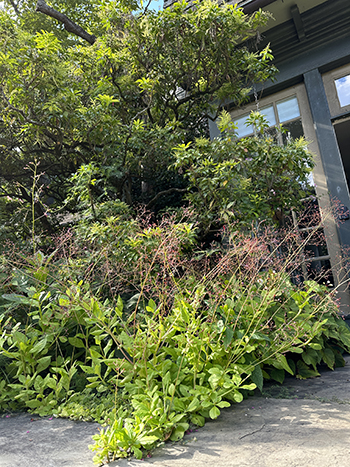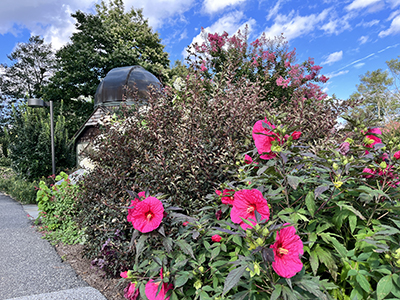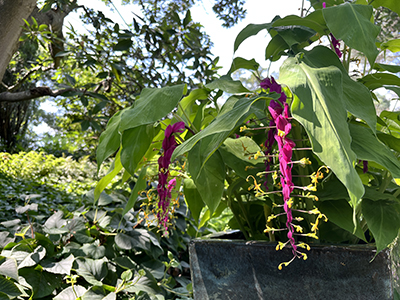
Plants of the Week: August 14
Guest Authors: Devin Dawson and Fabienne Adler, 2023 Summer Interns
As we summer interns prepare to say goodbye to the Scott Arboretum, our home away from home for the past twelve weeks, we take stock of the relationships we’ve been privileged to form here with plants, people, and place. Our final offering for “Plants of the Week” is an ode to Scott Arboretum’s fabulous horticulturist and to the tropic-inspired gems he masterfully embeds into the gardens surrounding the Scott Arboretum offices. Here’s to a master of the craft and to a truly unforgettable summer.

First off this week, we couldn’t pass on the opportunity to introduce a delightful duo that had us do a double take. Talinum paniculatum ‘Kingwood Gold’, jewels of Opar, and Ipomoea quamoclit, cypress vine, team up to brighten the edge of the path in the Terry Shane Teaching Garden.
Talinum is looking its best just now, balancing tiny, jewel-toned fruit on long stems above its chartreuse succulent foliage. The delicate, feathery leaves of Ipomoea vine their way around and through Panicum —and up into the venerable Pieris japonica above it. At first glance, it’s as if the two small plants had merged into a singular tropical gem. Both T. paniculatum and I. quamoclit are indeed native to tropical America and enjoy similar growing conditions, preferring full sun but tolerating light shade, and favoring dryer soils. Both plants are annuals in our climate—though T. paniculatum is perennial in warmer zones— and easily grown from seed. Generous self-sowing ensures that they return each year to perform their joint magic.

Plants that bring an exotic feel to the garden but don’t need to be dug out and spend the winter months indoors get lots of points in our book—think Musa basjoo (Japanese banana), Passiflora incarnata (purple passionflower), or even Magnolia macrophylla (bigleaf magnolia). Hibiscus moscheutos (swamp mallow) fits the bill with panache, and we just have to tell you about thedelightfulspecimen at the outer edge of the Terry Shane Teaching Garden, right off College Avenue.
Like an exclamation point at the end of a very good sentence, it is currently bursting with a profusion of dark-pink blooms as big as the proverbial dinner plate. Each bloom’s soft, creased petals and buttery stamens invite you to bury your face in them—just check that a bumblebee isn’t in there first! Unlike tender tropical Hibiscus that tend to be of the woody variety, hardy Hibiscus are herbaceous perennials that die back in late fall and send out new stems each spring. They want full sun, frequent deep waterings, and a prime spot in which they can rightfully show off.

To finish with a bang, here’s a tender ornamental ginger with a really zany bloom. Globba winitii (dancing girl ginger) is one of the treasures that survives our cold winters by retreating into the greenhouse, where its rhizomes patiently plot a spring comeback. Warming weather brings up clumps of attractive, elongated, tender-green leaves that eventually shield out-of-this-world blooms in late summer. The pendant inflorescence features magenta bracts shaped like exotic miters, and tiny tubular orange flowers borne on long purple stalks. This bloom looks like a science fiction illustration, and while some of the names for Globba cultivars liken it to a ‘dancing girl,’ we’re thinking more along the lines of ‘tropical alien queen.’ G. winitii requires a good measure of shade to protect its foliage from sunburn, rich organic soil, as well as excellent drainage (think perlite). Come see this gem in a seasonal container tucked in the Scott Entrance Garden.





No Comments